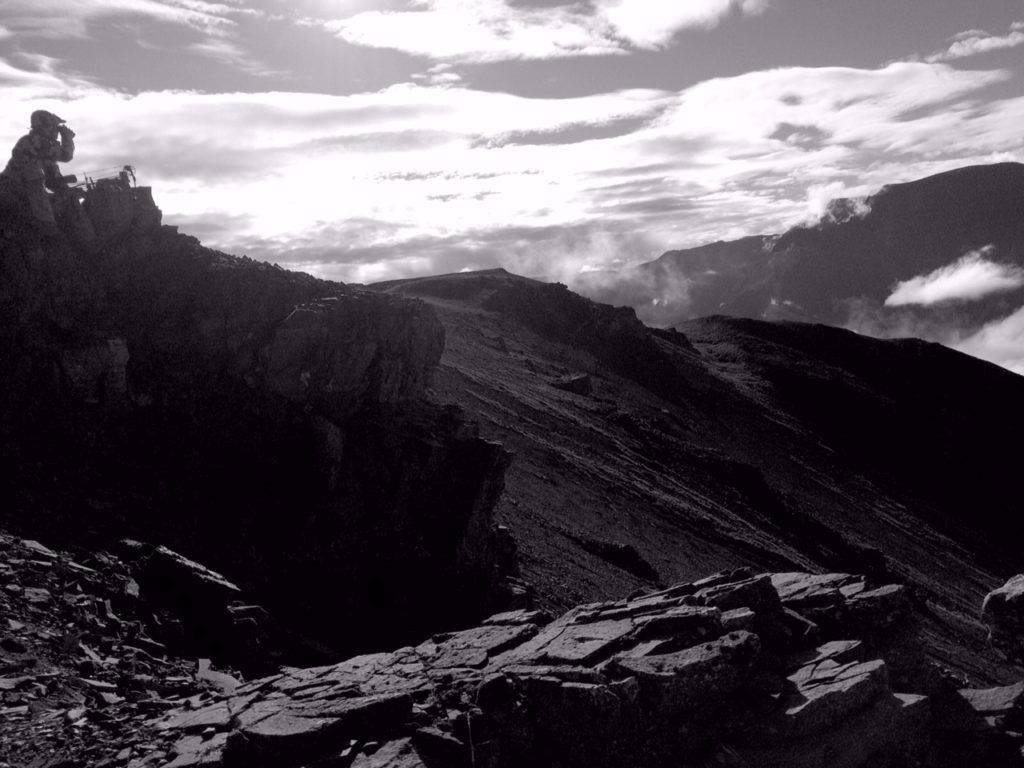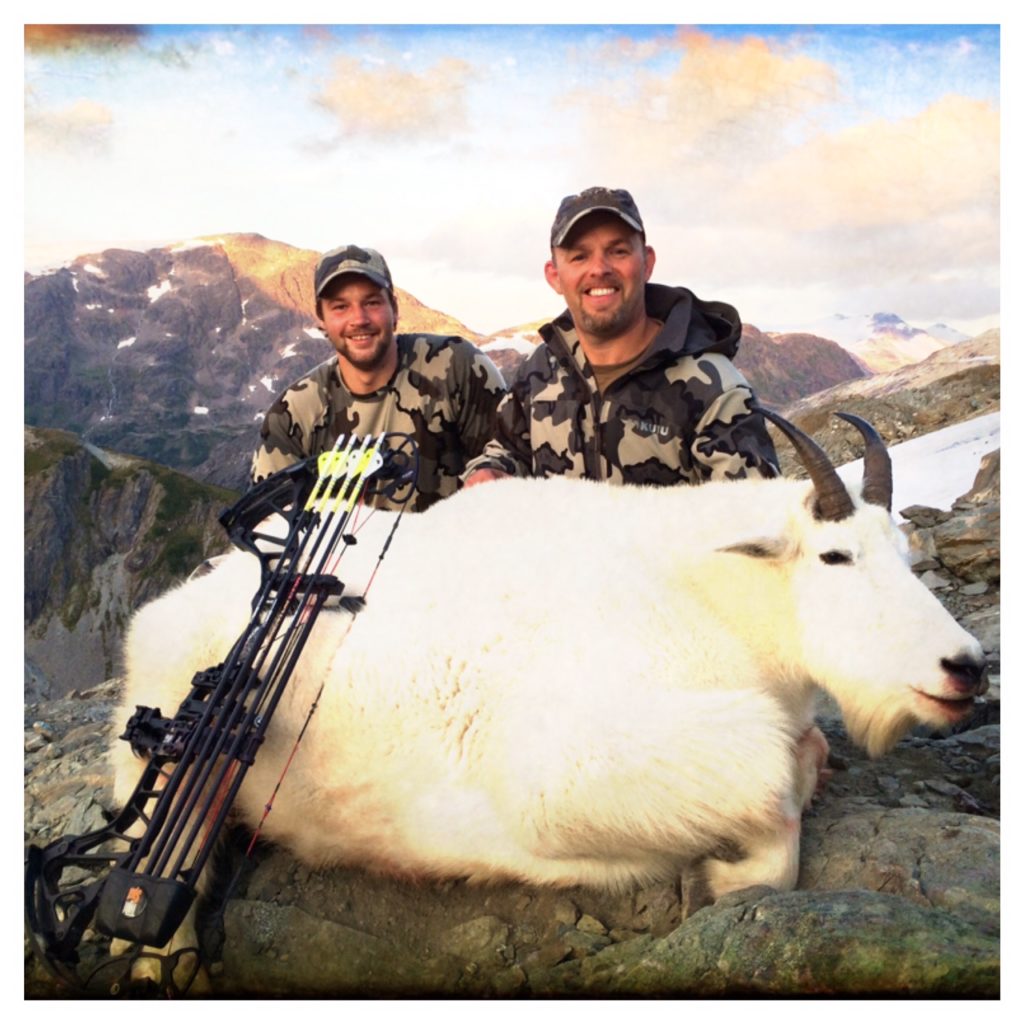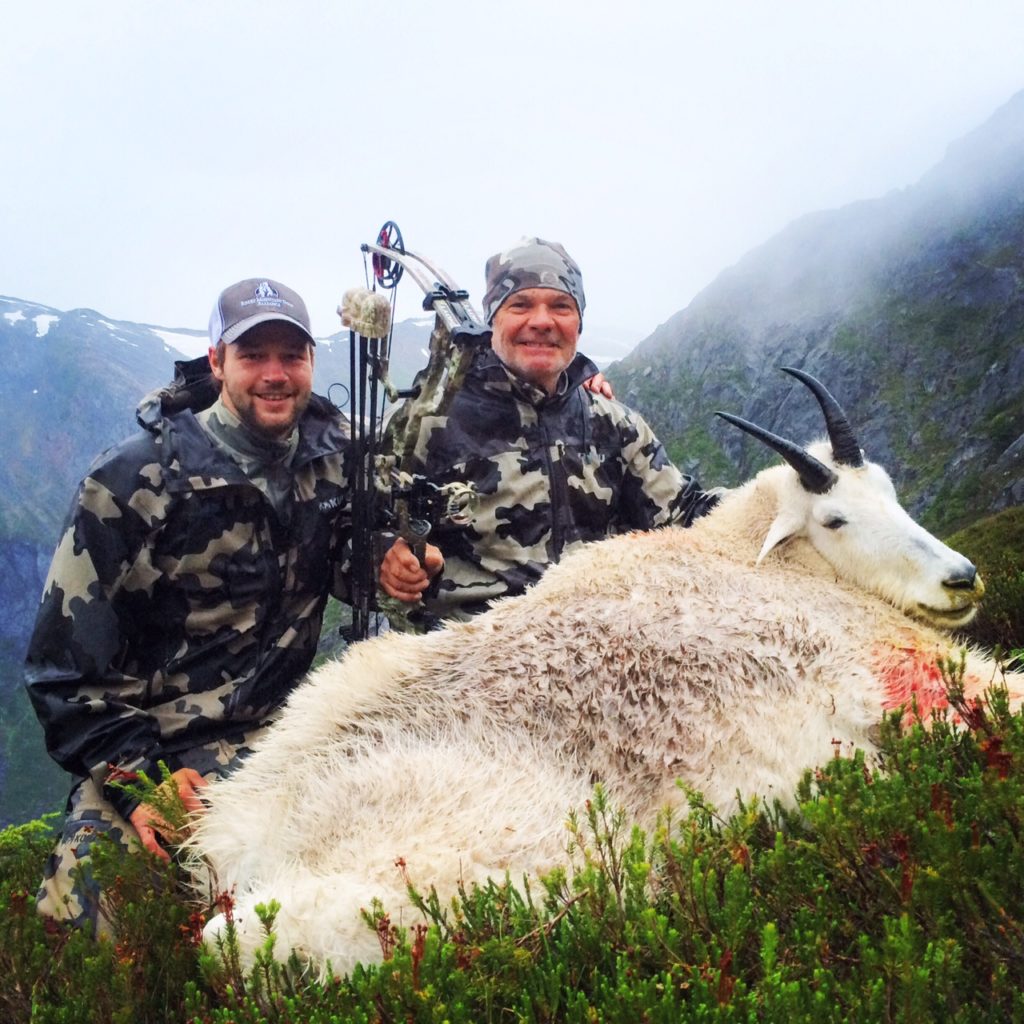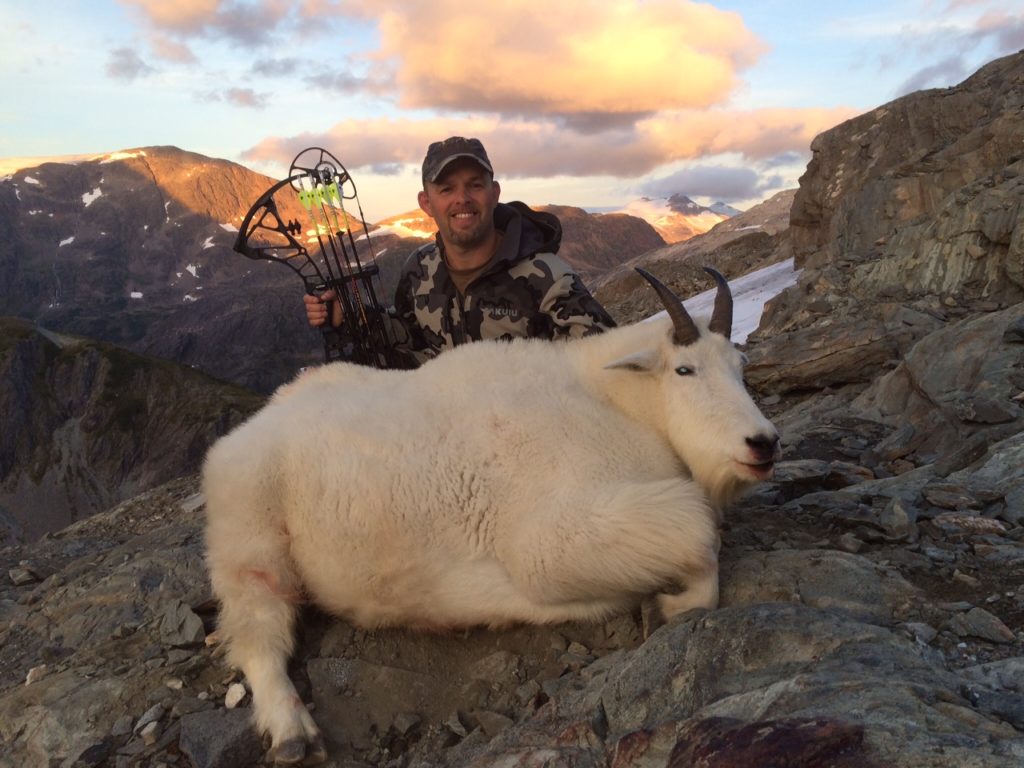“Sheep hunting is without question one of the most physically and mentally demanding hunting experiences available to the mountain hunter.” This quote from Dustin Roe’s So You Wanna Hunt Sheep Article in the August 2014 Issue of the JOMH is entirely accurate. However, there is another mountain dwelling species that deserves as much if not more respect from the dedicated mountain hunter: Oreamnos americanus, the Rocky Mountain Goat.
It’s often said that when Stone sheep hunting, if you find yourself among the goats, look down. In truth, mountain goats literally spit down on sheep. No other mountain ungulate is as capable or as tough to put in the salt, period. Whether your goat hunting endeavour takes you into the intimidating costal ranges of BC, the steep crags of AK, or the chalky bluffs of the lower 48 a goat hunt will test your physical capabilities, mental grit, patience and perseverance above and beyond virtually any other mountain hunt in North America. Commonly referred to as the “poor mans sheep hunt”, most people overlook the fact that goat hunting is actually THE challenge for the devout mountain hunter. Given their relatively widespread populations and the reasonable costs associated with a guided hunt, these animals in my opinion should be on every mountain hunter’s radar. In this article I will use the same structure as Dustin’s article to try and help you understand what to expect and how to plan and prepare for one of these ultimate mountain adventures.
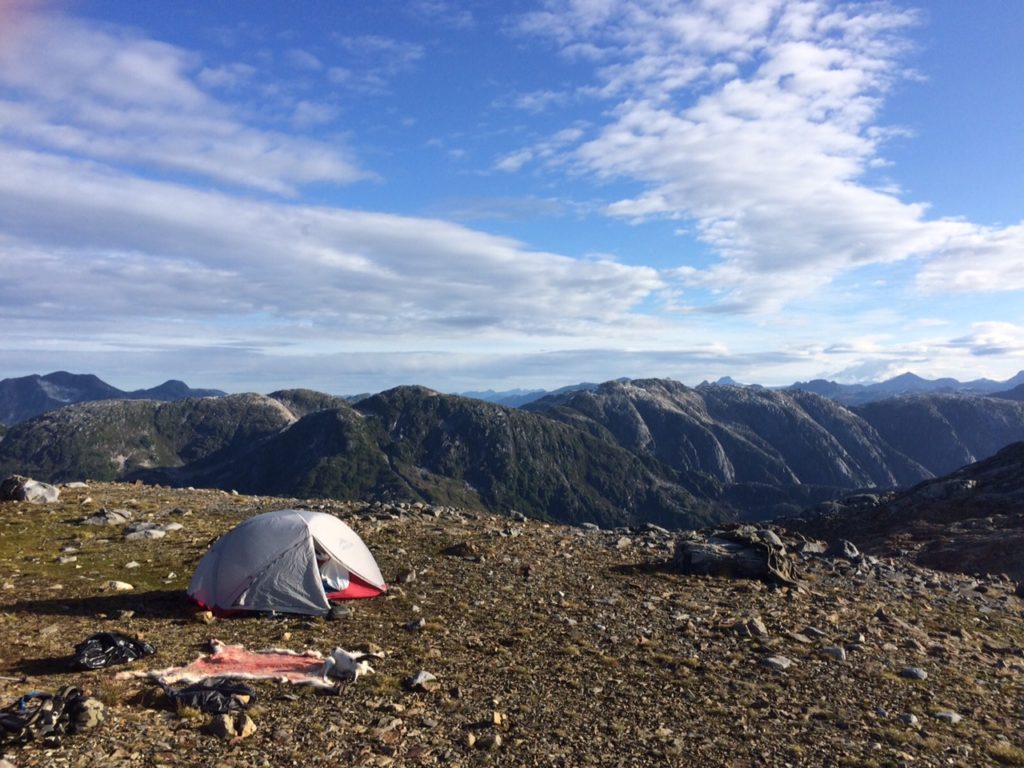
COST
If you’re lucky enough to be a resident in certain Provinces and States you have the opportunity to enter your regional draw system for the chance to hunt mountain goats and if you’re really lucky you’ll have general open season (GOS) opportunities or units to choose from. The cost for a self-guided goat hunt can be far less than a self-guided sheep hunt due mostly to the fact that a goat focused trip does not need to be in the 10 day plus range nor does it necessarily require a fly-in or other form of expensive transport.
For those who do not call these areas home, a guide outfitter will need to be hired to help you accomplish your mountain goat goals. As with most guided hunts, costs vary significantly dependent on the outfitter’s reputation, and the time of year you want to hunt. For around the same price as a Dall sheep hunt, you can choose anything from a high alpine early season archery hunt to chasing a long-haired billy in February. A solid, reliable outfitter will cost anywhere from $11,000 – $20,000 before taxes, tags, and trophy fees, and you should expect a waiting list. Gear costs may be a factor if you don’t regularly hunt mountainous terrain, and travel costs can be everything from relatively simple to highly involved if hunting a truly remote area. Most outfits will send you a gear list of what you’ll need on the hunt. Food, and float or bush plane costs will usually be covered in the base cost of the hunt.
SELECTING AN OUTFITTER
Start with extensive research online then start tracking down word of mouth referrals through Internet forums, friends and acquaintances and references from the outfitters themselves. Conventions and trade shows are the best way to find a guide outfitter that will suit your needs and abilities as you’ll be able to shop around and get to know each outfitter and their hunting style and area face-to-face. The trophy quality you expect will play a huge role in which area and outfit you choose for your hunt. That being said, any experienced goat hunter will tell you they’re all “trophies” and you’ll soon learn that the scenery, challenge and atmosphere of the hunt is worth far more than saving a few dollars. If you’re brave enough to seek mountain goats with archery equipment there are outfits that specialize in this hunting style so make sure you emphasize that need right out of the gates when discussing a potential hunt. If a specific outfitter costs more it’s probably for good reason. Certain areas of the world hold larger record book quality goats. I’m not biased to any single outfitter, but there are definitely some outfits with considerably more compassion for the hunt, and the clients’ experience and well being than others. Do your homework! It’s usually worth the wait for a year or two to get the outfit and area you truly want.
GEAR
As mentioned above most outfitters will send you a list of everything you should have in your possession well before the hunt date. If you’re an experienced mountain hunter you’ll likely have bombproof gear that will do just fine. Most people don’t. If you have absolutely no idea what you need then stick to the list and ask questions well in advance! Quality mountain hunting gear can be hard to track down depending on the time of year so do NOT to leave your shopping to the last minute. It’s also very important to test your gear before the hunt so, again do not wait till the 11th hour to order or purchase your gear.
A good frame pack in the 5000+ cubic inch range is a must. I personally use a 7200 for our 10 day hunts. These packs are great and they compress down small and tight for day hunts when needed. Nowadays, mountain hunters have a variety of options for outerwear and layering systems. You need to focus on the quality of your apparel system and not the camo pattern. It doesn’t matter how much research you do, you’re always going to find pros and cons, and people that hate this and love that. If you don’t have a clothing system you’ve personally tested and have experience with, then I recommend listening to your outfitter. They’ll know what gear and apparel work best in their specific area. As an example a Coastal goat hunt is very different from a Utah goat hunt and the gear the outfitter recommends will have been tested and proven in their specific climate and conditions.
BOOTS, BOOTS, BOOTS! The most important item on your gear list bar none! Everyone’s foot is different, find what fits you best and expect to spend a lot of time trying and testing various models and brands. If you’re spending under $300 they probably don’t belong in goat country. I recommend a stiff shank, and super feet insoles. Boots should be the absolute first item you check off your gear list so you have adequate time to break them in. Do not show up in brand new, freshly unpacked boots!
Good quality, collapsible hiking poles, a 2L or larger water bladder, and spare Nalgene or similar water bottles are a must as well. You will likely be sweating non-stop when you’re moving and staying hydrated is essential. As I’m sure you’ve read before, good glass is everything on a mountain hunt. You will be spending a lot of time behind your binoculars. This is another piece of kit you should not buy last minute. Make sure they don’t hurt your eyes well ahead of time, certain glass works well for some and not so well for others. It is also a good idea to invest in a bino bivy to protect them, and keep the lenses clean from debris and fog. Your guide will have a spotting scope, so I generally don’t recommend adding ounces to your pack with one.
If you’re going on an archery hunt then shoot a bow that you’re comfortable with not just the fastest one you can find that year. Practice, practice, practice! You should do your best to be confident out to 60 yards. If you’re confident past that range even better. In my opinion fixed pins are best, but single pins will make do if that’s what you prefer. Carbon arrows are absolutely the way to go. Most people that bring aluminum arrows into the mountains destroy them. A lot of people are caught up in bow speed these days, which isn’t a bad thing, but it should be noted that goats are incredibly tough animals. You should try and have a finished arrow product weighing 400+ grains. I prefer fixed two blade broad heads but fixed three blades are also an excellent choice. A lot of my friends and colleagues like mechanical heads as well but I’m not convinced they’re as effective as a solid two blade or three blade broad head that penetrates deeply. In the end, shoot what you shoot best out to the distances noted above. A good quiver that mounts solid to your bow is a must, holding at least six arrows. I also never travel into the backcountry without an arrow tube in my kit.
Rifles are a lot easier to work with. Make sure it has good glass, and that you’re confident out to 400 yards. Flat shooting fast calibers are preferred. Something like a 270wsm or 7mm-08 are good choices at the lighter end of the spectrum and anything in the .300 calibers will do the job just fine. Note if rifle hunting listen to your guide! You will find lots of goats in shooting distance, but you will not always be able to retrieve them!!
Whether with your archery equipment or rifle be sure to practice steep angle shots. There’s a reason mountain goats have earned the nickname “Cragmasters” and you can expect to have to make a shot that will be far from the conditions you’re used to in your backyard, the archery range or rifle range. Make sure your rangefinder has an angle compensator function built in.
FITNESS
This is the hardest thing you will ever do. That is not an understatement. Train, train, and train some more. If you have a real mountain to hike, go there. If you’re not accustomed to hiking start on the trails or path then get off it as much as possible. Pick a line up the hill or mountain and get after it. I cannot emphasize this point enough: get off-trail as soon as your body gets comfortable with the terrain and elevation. And practice side hilling, you will be doing a lot of it.
No mountain? Then get in the gym. The Mountain Fitness column the JOMH team runs every month has tons of info on how to prepare for mountain hunts so read their material thoroughly. At minimum, go find a stepmill at the gym and start logging hours in your boots with your pack. I’m a fan of body weight exercises that keep you strong but not bulky, but make sure to go heavier on the legs. Honestly if you’re not going to train before hand don’t go! Save your money, you’ll be doing both you and your guide a favour.
WHAT TO EXPECT
You can almost always expect to experience some unfortunate weather. Rain, snow, fog, and wind are a given in Coastal goat habitats and very likely in most mountainous terrain at some point in a hunt. Get an Ereader before hand and load it with some books. There is nothing worse than being stuck in a tent for half your hunt reading the same mountain house package over and over.
Expect to see goats in impossible places. Like I said earlier, you will see many you simply cannot get to or more importantly retrieve after the shot. But in the long run if you have some decent weather, a bit of luck, and put in a ton of hard work you can expect a beautiful billy to accompany you home.
If you look at many successful goat hunt photos you will notice that very few hunters are smiling. This is either because of what they just went through, or what they’re about to go through. Keep that in mind because it’s what you’re signing up for. Whether you’re doing this solo or with a guide remember to keep a positive mind set because nothing will crush your chances and the spirit of the hunt faster than a negative attitude. As guides we certainly don’t do it for the money, but for the life style and we want to be out there just as much as you do.
For most of us this is far more than a hunt, it is an addiction. If you make the decision to pursue the “Beast the Colour of Winter” you’ll soon learn that dreams of big billies don’t just fade away after a hunt. The passion for the peaks, cliffs and crags they call home will get in your blood. It’ll be there when you go to bed at night, and it’ll be there when you wake up in the morning. Not a day goes by that I don’t think about arrowing a mature billy. Consider yourself warned! Poor man’s sheep hunt? I think you know where I stand on that BS!
Good luck to everyone reading this article. Send your photos to www.goatalliance.org so you can share your experience with myself and other “goaties”.



